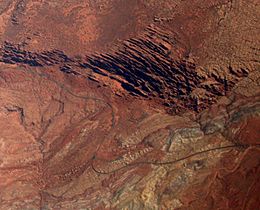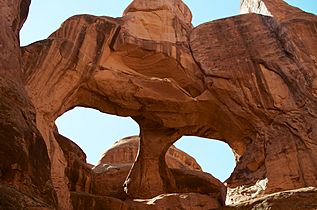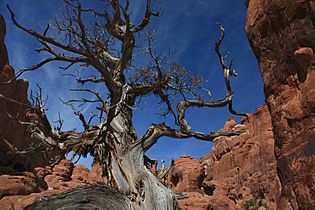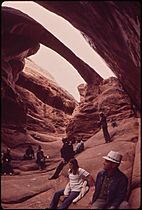Fiery Furnace (Arches National Park) facts for kids
The Fiery Furnace is an amazing area of narrow sandstone canyons, rock fins, and natural arches. It's found in the middle of Arches National Park in Utah, United States. This spot is very popular for hiking. It got its name because the rocks glow with a reddish color when the sun sets, making it look like a fiery place!
Contents
What Makes the Fiery Furnace Special?
The Fiery Furnace is home to many different kinds of plants. One special plant found here is the Canyonlands biscuitroot, and this area has one of the largest groups of them known! You can also find delicate things like biological soil crust (which is a living layer on the ground) and temporary pools of water called ephemeral pools. These natural features are very fragile and can be easily damaged by people walking through.
Arches National Park has over 2,000 cataloged sandstone arches, and some of them are right here in the Fiery Furnace! Some of the cool arches you might see include:
- Walk Through Arch
- Crawl Through Arch
- Skull Arch
- Kissing Turtles Arch
- Surprise Arch
Exploring the Fiery Furnace: Permits and Tours
Because the Fiery Furnace is so special and fragile, the National Park Service started a permit system in 1994. This helps to limit how many people can visit at one time, protecting the area from too much damage.
How Can You Visit?
Visitors have two main ways to explore the Fiery Furnace:
- Self-guided permit: You can get a permit to hike through the Fiery Furnace on your own. If you choose this, you must watch a video first. This video teaches you about the area and how to explore it without harming the delicate plants and rocks.
- Ranger-guided tour: You can join a park ranger for a guided tour. This tour is about 2 mi (3.2 km) long and usually lasts around three hours. The rangers will lead you through the maze of rocks, pointing out interesting arches and telling you about the history of the area.
When you enter the Fiery Furnace, there are two main trails from the parking lot. But once you are inside, there are no marked trails! It's like a natural labyrinth (a maze) of rock formations. To protect the plants and soil, visitors are asked to walk only on sandy washes or on the bare sandstone surfaces. The ranger-guided tour can be a bit challenging, with uneven ground, places where the ground drops off, and narrow passages you might have to squeeze through.
Images for kids






